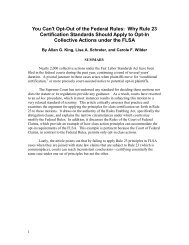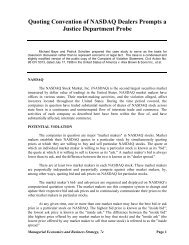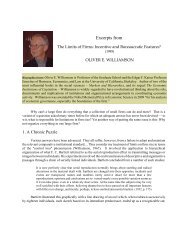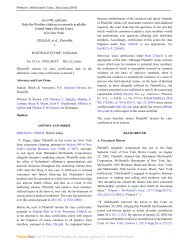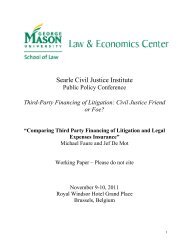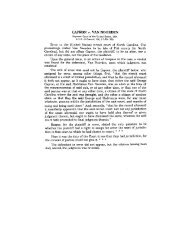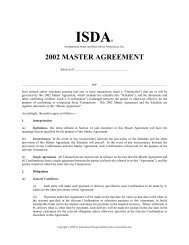Jelle Vlaanderen, et al., Occupational Benzene Exposure and the ...
Jelle Vlaanderen, et al., Occupational Benzene Exposure and the ...
Jelle Vlaanderen, et al., Occupational Benzene Exposure and the ...
Create successful ePaper yourself
Turn your PDF publications into a flip-book with our unique Google optimized e-Paper software.
<strong>Vla<strong>and</strong>eren</strong> <strong>et</strong> <strong>al</strong>.<br />
association b<strong>et</strong>ween benzene <strong>and</strong> AML. We<br />
argue that any study that was not able to<br />
d<strong>et</strong>ect at least a suggestive association b<strong>et</strong>ween<br />
benzene <strong>and</strong> AML most likely had serious<br />
m<strong>et</strong>hodologic limitations in one or more<br />
aspects of study design. Examples of possible<br />
limitations are trivi<strong>al</strong> exposure to benzene in<br />
<strong>the</strong> studied cohort, inclusion of “unexposed”<br />
workers in “exposed” categories or flaws in <strong>the</strong><br />
assessment (or categorization) of he<strong>al</strong>th effects<br />
(Goldstein <strong>and</strong> Sh<strong>al</strong>at 2000). Therefore, we<br />
used <strong>the</strong> direction <strong>and</strong> significance level of<br />
a reported association b<strong>et</strong>ween benzene <strong>and</strong><br />
AML as proxies for <strong>the</strong> over<strong>al</strong>l study qu<strong>al</strong>ity<br />
(AML significance level).<br />
We based <strong>the</strong> third strategy on <strong>the</strong> ev<strong>al</strong>uation<br />
of <strong>the</strong> qu<strong>al</strong>ity of <strong>the</strong> exposure assessment<br />
carried out in each cohort. High-qu<strong>al</strong>ity<br />
exposure assessment is essenti<strong>al</strong> to discriminate<br />
exposed individu<strong>al</strong>s from nonexposed<br />
individu<strong>al</strong>s (<strong>Vla<strong>and</strong>eren</strong> <strong>et</strong> <strong>al</strong>. 2008). We<br />
assigned an exposure assessment qu<strong>al</strong>ity classification<br />
to each study based on an a priori<br />
defined classification scheme <strong>and</strong> used this<br />
classification as an addition<strong>al</strong> proxy of study<br />
qu<strong>al</strong>ity, reasoning that those cohort studies<br />
with <strong>the</strong> highest qu<strong>al</strong>ity exposure assessment<br />
had <strong>the</strong> greatest ability to identify <strong>and</strong> include<br />
workers who were truly exposed to benzene in<br />
<strong>the</strong>ir an<strong>al</strong>yses.<br />
We hypo<strong>the</strong>sized that application of <strong>the</strong><br />
three study qu<strong>al</strong>ity dimensions—stratification<br />
based on <strong>the</strong> start of follow-up, AML significance<br />
level, <strong>and</strong> exposure assessment qu<strong>al</strong>ity—<br />
would identify a subgroup of occupation<strong>al</strong><br />
cohort studies that is most informative for <strong>the</strong><br />
ev<strong>al</strong>uation of <strong>the</strong> possible association b<strong>et</strong>ween<br />
benzene <strong>and</strong> lymphoid neoplasms.<br />
Materi<strong>al</strong>s <strong>and</strong> M<strong>et</strong>hods<br />
Study identification <strong>and</strong> data extraction.<br />
We conducted a search of PubMed (http://<br />
www.ncbi.nlm.nih.gov/sites/entrez) using <strong>the</strong><br />
key words “benzene” <strong>and</strong> “cohort” or “case–<br />
control.” We included publications in <strong>the</strong><br />
m<strong>et</strong>a- an<strong>al</strong>ysis if <strong>the</strong>y were published in <strong>the</strong> peerreviewed<br />
literature, reported results for any of<br />
<strong>the</strong> five lymphoma subtypes (HL, NHL, MM,<br />
ALL, <strong>and</strong> CLL), <strong>and</strong> were conducted in <strong>the</strong><br />
occupation<strong>al</strong> s<strong>et</strong>ting. We checked references in<br />
<strong>al</strong>l identified publications for addition<strong>al</strong> studies.<br />
When more than one paper was published on<br />
<strong>the</strong> same cohort, we chose <strong>the</strong> publication with<br />
<strong>the</strong> highest qu<strong>al</strong>ity exposure assessment [e.g.,<br />
in <strong>the</strong> Austr<strong>al</strong>ian p<strong>et</strong>roleum workers cohort for<br />
AML, we chose <strong>the</strong> nested case–control study<br />
that included an elaborated exposure assessment<br />
approach (Glass <strong>et</strong> <strong>al</strong>. 2003) over a more<br />
recent update on <strong>the</strong> full cohort that included<br />
no d<strong>et</strong>ailed benzene exposure assessment (Gun<br />
<strong>et</strong> <strong>al</strong>. 2006)]. When multiple publications with<br />
similar qu<strong>al</strong>ity of exposure assessment were<br />
published on <strong>the</strong> same cohort, we chose <strong>the</strong><br />
most recent update (with <strong>the</strong> longest follow-up<br />
time). In this m<strong>et</strong>a- an<strong>al</strong>ysis, we pooled risk<br />
ratios, odds ratios (ORs), <strong>and</strong> st<strong>and</strong>ardized<br />
mort<strong>al</strong>ity ratios (SMRs). ORs <strong>and</strong> SMRs can<br />
be interpr<strong>et</strong>ed as reasonable approximations of<br />
<strong>the</strong> risk ratio when <strong>the</strong> disease is rare, <strong>and</strong> <strong>the</strong>se<br />
measures have been pooled with risk ratios for<br />
m<strong>et</strong>a- an<strong>al</strong>yses before (McElvenny <strong>et</strong> <strong>al</strong>. 2004).<br />
We use <strong>the</strong> term “relative risk” (RR) to refer<br />
to <strong>the</strong> risk ratio, <strong>the</strong> OR, or <strong>the</strong> SMR. We<br />
extracted RRs based both on incidence <strong>and</strong><br />
mort<strong>al</strong>ity. However, if a publication reported<br />
both, we chose incidence over mort<strong>al</strong>ity in <strong>the</strong><br />
m<strong>et</strong>a- an<strong>al</strong>ysis.<br />
Risk estimates. To <strong>al</strong>low <strong>the</strong> inclusion of<br />
studies without quantitative exposure assessment<br />
in our an<strong>al</strong>ysis, we used only RRs for<br />
“any occupation<strong>al</strong> benzene exposure” versus<br />
“background benzene exposure” in <strong>the</strong> m<strong>et</strong>aan<strong>al</strong>yses.<br />
If publications reported only RRs<br />
stratified for cumulative exposure <strong>and</strong> not for<br />
“any occupation<strong>al</strong> benzene exposure” versus<br />
“background benzene exposure,” we pooled<br />
RRs by summing observed <strong>and</strong> expected cases<br />
for studies that reported SMRs (percentage of<br />
RRs: AML, 4.8%; HL, 3.7%; NHL, 3.0%;<br />
MM, 3.8%; CLL, 5.6%) or by conducting a<br />
within-study r<strong>and</strong>om-effects m<strong>et</strong>a- an<strong>al</strong>ysis of<br />
<strong>the</strong> nonreference exposure groups for studies<br />
that reported RRs or ORs (percentage of<br />
RRs: AML, 14.3%; NHL, 3.0%; MM, 7.7%;<br />
ALL, 5.9%; CLL, 16.7%). If publications<br />
reported only observed <strong>and</strong> expected number<br />
of cases <strong>and</strong> no RRs, we c<strong>al</strong>culated RRs <strong>and</strong><br />
estimated associated confidence interv<strong>al</strong>s (CIs)<br />
with mid-P exact (Rothman <strong>and</strong> Boice 1979)<br />
(percentage of RRs: AML, 4.8%; HL, 7.4%;<br />
ALL, 17.6%). For publications that reported<br />
no observed cases for any of <strong>the</strong> lymphoma<br />
subtypes, we c<strong>al</strong>culated continuity corrected<br />
RRs (observed <strong>and</strong> expected number of cases<br />
plus one) <strong>and</strong> we estimated associated CIs<br />
with mid-P exact (percentage of RRs: ALL,<br />
11.8%; HL, 11.1%). If studies reported zero<br />
for <strong>the</strong> lower CI, we imputed a v<strong>al</strong>ue of 0.1 to<br />
<strong>al</strong>low estimation of <strong>the</strong> variance (percentage<br />
of RRs: ALL, 5.9%; MM, 3.8%).<br />
Three strategies for <strong>the</strong> assessment of study<br />
qu<strong>al</strong>ity dimensions. We stratified by <strong>the</strong> year<br />
of start of follow-up based on <strong>the</strong> information<br />
provided in <strong>the</strong> included publications<br />
(follow-up started before 1970 vs. follow-up<br />
started in or after 1970). The median start<br />
of follow-up in <strong>the</strong> stratum with studies that<br />
started follow-up before 1970 was 1947, <strong>and</strong><br />
<strong>the</strong> median start of follow-up in <strong>the</strong> stratum<br />
with studies that started follow-up in 1970 or<br />
after was 1973.<br />
We assigned AML significance level to<br />
each publication based on a two-sided p-v<strong>al</strong>ue<br />
of <strong>the</strong> z-score, which we estimated by dividing<br />
<strong>the</strong> reported log RR for AML by its st<strong>and</strong>ard<br />
error. Based on <strong>the</strong> c<strong>al</strong>culated AML significance<br />
level, we assigned one of <strong>the</strong> following<br />
categories (A–E) to each publication: A, AML<br />
RR > 1, p < 0.1; B, AML RR > 1, 0.1 ≤ p<br />
< 0.2; C, AML RR > 1, p ≥ 0.2; D, AML RR<br />
≤ 1; E, no AML RR reported.<br />
We assigned qu<strong>al</strong>ity of exposure assessment<br />
(A–D) to each publication as follows: A,<br />
in <strong>the</strong> publication explicit quantitative exposure<br />
estimates for benzene were reported; B,<br />
in <strong>the</strong> publication semiquantitative estimates<br />
of benzene exposure or quantitative estimates<br />
of exposures containing benzene (e.g., gasoline)<br />
were reported; C, in <strong>the</strong> publication<br />
some industri<strong>al</strong> hygiene sampling results to<br />
indicate that benzene exposure was present<br />
in <strong>the</strong> cohort that was studied were reported;<br />
D, <strong>the</strong> publication qu<strong>al</strong>itatively indicated that<br />
benzene exposure was present in <strong>the</strong> cohort.<br />
Statistic<strong>al</strong> an<strong>al</strong>yses. We conducted r<strong>and</strong>omeffects<br />
m<strong>et</strong>a- an<strong>al</strong>yses to pool <strong>the</strong> RRs reported<br />
in <strong>the</strong> included publications. We used an α<br />
of 0.05 to assess wh<strong>et</strong>her m<strong>et</strong>a-relative risks<br />
(mRRs) were significantly elevated. We conducted<br />
<strong>the</strong> first s<strong>et</strong> of m<strong>et</strong>a- an<strong>al</strong>yses on <strong>the</strong> full<br />
s<strong>et</strong> of studies stratified for <strong>the</strong> start of follow-up<br />
(follow-up started before 1970 vs. follow-up<br />
started in or after 1970). We compared mRRs<br />
by strata using a test of interaction as suggested<br />
by Altman <strong>and</strong> Bl<strong>and</strong> (2003).<br />
We applied <strong>the</strong> study qu<strong>al</strong>ity dimensions<br />
of AML significance level <strong>and</strong> qu<strong>al</strong>ity of exposure<br />
assessment in two series of m<strong>et</strong>a- an<strong>al</strong>yses.<br />
The initi<strong>al</strong> an<strong>al</strong>ysis in each series included<br />
<strong>al</strong>l studies regardless of qu<strong>al</strong>ity. In each subsequent<br />
an<strong>al</strong>ysis, we excluded <strong>the</strong> group of<br />
studies with <strong>the</strong> lowest AML significance level<br />
or <strong>the</strong> lowest qu<strong>al</strong>ity of exposure assessment.<br />
We used Cochran’s Q-test to assess<br />
b<strong>et</strong>ween study h<strong>et</strong>erogeneity in <strong>al</strong>l m<strong>et</strong>aan<strong>al</strong>yses.<br />
A p-v<strong>al</strong>ue < 0.1 was considered to be<br />
statistic<strong>al</strong>ly significant evidence for b<strong>et</strong>ween<br />
study h<strong>et</strong>erogeneity. We used I 2 to describe<br />
<strong>the</strong> percentage of tot<strong>al</strong> variation across studies<br />
that was due to h<strong>et</strong>erogeneity ra<strong>the</strong>r than<br />
chance (Higgins <strong>et</strong> <strong>al</strong>. 2003). For an<strong>al</strong>yses<br />
that displayed significant b<strong>et</strong>ween study<br />
h<strong>et</strong>ero geneity, we assessed <strong>the</strong> sensitivity of<br />
<strong>the</strong> outcome of <strong>the</strong> m<strong>et</strong>a- an<strong>al</strong>ysis for individu<strong>al</strong><br />
studies by excluding studies one at <strong>the</strong><br />
time (jackknife an<strong>al</strong>ysis). We assessed publication<br />
bias with Eggers graphic<strong>al</strong> test (Egger<br />
<strong>et</strong> <strong>al</strong>. 1997). We performed <strong>al</strong>l m<strong>et</strong>a- an<strong>al</strong>yses<br />
in Stata (version 11; StataCorp LP, College<br />
Station, TX, USA).<br />
Results<br />
We identified 44 publications that provided<br />
an RR for at least one of <strong>the</strong> lymphoma<br />
subtype–specific m<strong>et</strong>a- an<strong>al</strong>yses. We did not<br />
extract data from three publications: one<br />
study with likely underascertainment of cancer<br />
deaths as <strong>the</strong> result of <strong>the</strong> inability to identify<br />
<strong>the</strong> type of cancer for a number of cancer<br />
deaths (Infante 2005; Sorahan <strong>et</strong> <strong>al</strong>. 2005);<br />
one study for which we could not estimate<br />
<strong>the</strong> RR variance [a nested case–control study<br />
160 v o l u m e 119 | number 2 | February 2011 • Environment<strong>al</strong> He<strong>al</strong>th Perspectives




